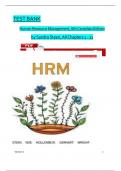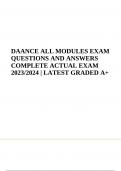TEST BANK
Human Resource Management, 6th Canadian Edition
by Sandra Steen, All Chapters 1 - 11
Version 1 1
,TABLE OF CONTENTS
SECTION 1: The Human Resource Environment
Chapter 1: Strategies, Trends, and Challenges in Human Resource
Management
Chapter 2: Equity, Fairness, Health, and Safety in the Workplace
SECTION 2: Preparing for and Acquiring Human Resources
Chapter 3: Analyzing Work and Designing Jobs
Chapter 4: Planning for and Recruiting Human Resources
Chapter 5: Selecting Employees
SECTION 3: Talent Management
Chapter 6: Training, Learning, and Development
Chapter 7: Managing Employees' Performance
SECTION 4: Compensating and Rewarding Human Resources
Chapter 8: Total Rewards
SECTION 5: Meeting Other HR Goals
Chapter 9: Labour Relations
Chapter 10: Managing Human Resources Globally
Chapter 11: Creating and Sustaining High-Performance
Organizations
Version 1 2
,Chapter 1: Strategies, Trends, and Challenges in Human Resource Management
Answers are at the End of Each Chapter
Student name:
1) Managers and economists traditionally have seen human resource management as a
source of value to their organizations.
⊚ true
⊚ false
2) The concept of "human resource management" implies that employees are
interchangeable, easily replaced assets that should be managed like any other physical
asset.
⊚ true
⊚ false
3) No two human resource departments will have precisely the same roles and responsibilities.
⊚ true
⊚ false
4) Recruitment refers to the process by which an organization selects applicants with the
right knowledge, skills, and abilities to help the organization achieve its goals.
⊚ true
⊚ false
5) Performance management requires that employee activities and outputs match
the individual's goals.
⊚ true
⊚ false
Version 1 3
,6) Important decisions in planning pay and benefits include how much to offer employees
in salary or wages, as opposed to bonuses, commissions, and other performance-
related pay.
⊚ true
⊚ false
7) The shift to self-service requires HR to spend more time on day-to-day transactional tasks.
⊚ true
⊚ false
8) Compliance with laws and regulations is not an HR responsibility, but rather the
sole responsibility of managers within the organization.
⊚ true
⊚ false
9) HR is increasingly becoming a purely administrative function.
⊚ true
⊚ false
10) As part of its strategic role, one of the key contributions HR can make is to engage
in evidence-based HRM.
⊚ true
⊚ false
11) Canada underperforms the United States with respect to productivity.
⊚ true
⊚ false
12) HRM should have a significant role in carrying out a merger or acquisition.
⊚ true
⊚ false
Version 1 4
,13) Non-traditional workers e.g. contractors and temporary workers, currently represent
more than 50 percent of the workforce, and this percentage is expected to increase
significantly.
⊚ true
⊚ false
14) Setting up a business enterprise in another country (e.g. building a factory in China) is
called outsourcing.
⊚ true
⊚ false
15) Recent surveys indicate that the general public and managers do not have
positive perceptions of the ethical conduct of businesses.
⊚ true
⊚ false
16) HR activities are carried out exclusively by HR specialists in small organizations.
⊚ true
⊚ false
17) Canada's labour force is aging.
⊚ true
⊚ false
18) Mobile devices are increasingly being used to access HR processes, information,
and collaborative tools.
⊚ true
⊚ false
Version 1 5
,19) As a type of resource, human capital refers to:
A) the wages, benefits, and other costs incurred in support of HR functions within
an organization.
B) executive talent within an organization.
C) the tax-deferred value of an employee's pension plan.
D) employee characteristics that can add economic value to the organization.
E) substitutes for physical assets.
20) Human capital refers to an organization's employees described in terms of all of
the following, EXCEPT?
A) Profitability
B) Training
C) Relationships
D) Intelligence
E) Experience
21) When an organization is better than competitors at something, and can hold that
advantage over a sustained period of time, it is said to have a:
A) differentiated focus.
B) sustainable competitive advantage.
C) core competency.
D) low-cost competitive advantage.
E) absolute advantage.
22) In the context of human resources, EX represents:
A) Experience level
B) Emotional intelligence
C) Employee engagement
D) Employee experience
E) Employee expectations
Version 1 6
,23) The degree to which employees are fully involved in their work and the strength of
their commitment to their organization is called:
A) employee engagement.
B) employee satisfaction.
C) core competency.
D) differentiated focus.
E) workplace potential.
24) Which one of the following refers to the process of getting detailed information about jobs?
A) Job design
B) Recruitment
C) Selection
D) Job analysis
E) Performance management
25) What do you call the process through which an organization seeks applicants for
potential employment?
A) Recruitment
B) Selection
C) Onboarding
D) Job analysis
E) Performance management
26) Development programs often focus on:
A) enabling employees to learn job-related knowledge, skills, and behaviour.
B) ensuring that employees' activities and outputs match the organization's goals.
C) preparing employees for leadership responsibilities.
D) identifying the top qualities employers look for in employees.
E) increasing the profitability of each employee.
Version 1 7
,27) Which one of the following refers to a planned effort to enable employees to learn job-
related knowledge, skills, and behaviours?
A) Orientation
B) Selection
C) Recruitment
D) Training
E) Development
28) The process of ensuring that employees' activities and outputs match the organization's
goals is called:
A) job analysis.
B) strategic management.
C) quality assurance.
D) performance management.
E) development.
29) Use of quantitative tools and scientific methods to analyse data from HR databases and
other sources to make evidence-based decisions is called:
A) people (human capital) analytics.
B) productivity improvement.
C) performance management.
D) strategic HRM.
E) self-service.
30) The COVID-19 pandemic put the role of into prominent focus as HR leaders
endeavoured to meet the needs of their organization’s workforce while navigating
changing legislation.
A) business partner services
B) strategic partner
C) administrative services
D) administrative transactions
E) stakeholder collaborator
Version 1 8
, 31) is a systematic and planned effort to train, develop, and engage the
performance of highly skilled employees and managers.
A) Evidence-based HRM
B) Job analysis
C) Talent acquisition
D) Talent management
E) Performance management
32) refers to demonstrating that human resource practices have a
positive influence on the company's profits or key stakeholders.
A) Strategy
B) Evidence-based HRM
C) Productivity improvement
D) Compliance
E) Performance management
33) Companies that rely primarily on non-traditional employment to meet service and
product demands are competing in the economy.
A) self-service
B) gig
C) contractor
D) on-demand
E) evolving
34) A small manufacturing company decides to have its accounting function performed by
a medium-sized accounting firm. This is an example of:
A) offshoring.
B) expatriation.
C) outsourcing.
D) joining forces through a merger.
E) productivity improvement.
Version 1 9






